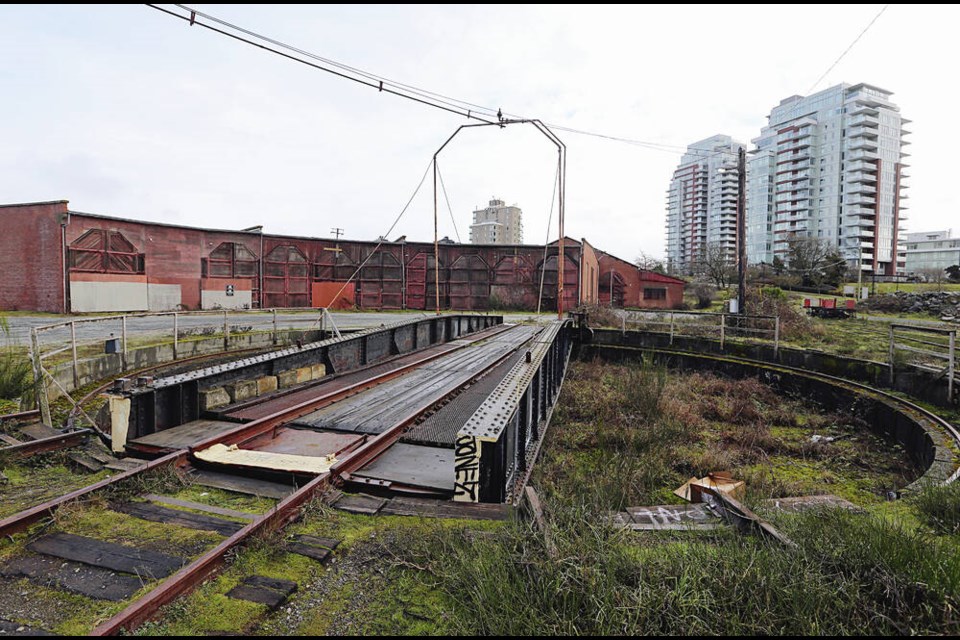The Roundhouse project in Vic West, which has been in the works for more than 15 years, will get a chance to deliver its promised 1,870 residential units and commercial space after Victoria council approved rezoning and amendments to the official community plan at a public hearing Thursday night.
While a number of councillors expressed misgivings with the proposal, noting it was far from perfect, council ultimately voted 7-2 in favour of third reading of the bylaw amendments.
The bylaws will be adopted at a later date, after concerns about the impact of the height of the development may have on the Inner Harbour airport have been addressed in consultation with Transport Canada.
Only councillors Stephen Hammond and Marg Gardiner voted against.
The approval means proponent Focus Equities will have the zoning it needs to move forward with a project that envisions nine buildings ranging in height from 10 to 32 storeys at 251 Esquimalt Rd., 210 Kimta Rd. and 355 Catherine St.
The project anticipates 1,870 residential units, including 215 units deemed affordable, 70,000 square feet of commercial space and the remediation and renovation of existing heritage buildings on the site.
Councillors who voted in favour of the project were Dave Thompson, Matt Dell, Jeremy Caradonna, Chris Coleman, Krista Loughton, Susan Kim and Mayor Marianne Alto. They said they were swayed by the amount of promised new housing, a potentially vibrant community in what is now empty space, and protection of the heritage site.
The councillors voting against, among other concerns, suggested the project was just too big for the site and that the existing heritage site would be dwarfed and overwhelmed by the new towers.
Thursday night’s public hearing was the continuation of a hearing that started Jan. 11 with in-person and online comments from residents and the Jan. 18 meeting when council watched 100 videos submitted by residents wanting to have their say.
In all, more than 150 people weighed in on the project.
The residents who spoke up about the project were split.
During the previous public hearings several residents stepped up to say it’s about time the 10 acres of empty land surrounding the Roundhouse national historic site was developed into a community with amenities and services for the neighbourhood.
But other residents expressed serious concerns about the size and scope of the proposal. Some urged development but with smaller buildings and more in line with the existing official community plan and development guidelines.
Many also expressed concerns that the historic site would be dwarfed and overwhelmed by the towers that surround it.
Alto kicked off Thursday’s meeting by taking the first hour to pose 25 questions to city staff and representatives of proponent Focus Equities.
The questions, which were meant to represent the concerns and questions raised by the public over the previous two meetings, covered a broad spectrum of topics from how the proposal fits into local neighbourhood plans and what effect it will have on infrastructure, to the number of affordable and accessible units there will be and if the fire department has any concerns about the size of the towers on the site.
The questions yielded more detail on what the proposal might look like — that while it is not consistent with the neighbourhood plan it is consistent with the goals of establishing a mixed-use community centred around the heritage precinct; that it promises 215 affordable units; and that across the entire project 20 per cent of the residential units would be considered adaptable to be made accessible.
Council learned the project would likely take 10 to 15 years before there would be significant build out and that the heritage remediation, affordable housing component and some market rental and some community amenities would be among the first phases to get underway.
It was also made clear that the fire department has no concerns about dealing with emergencies on the site despite the height and density of the buildings and that the city anticipates no problems with the underground infrastructure and that underground utilities would be upgraded to handle the growing population.
>>> To comment on this article, write a letter to the editor: [email protected]



